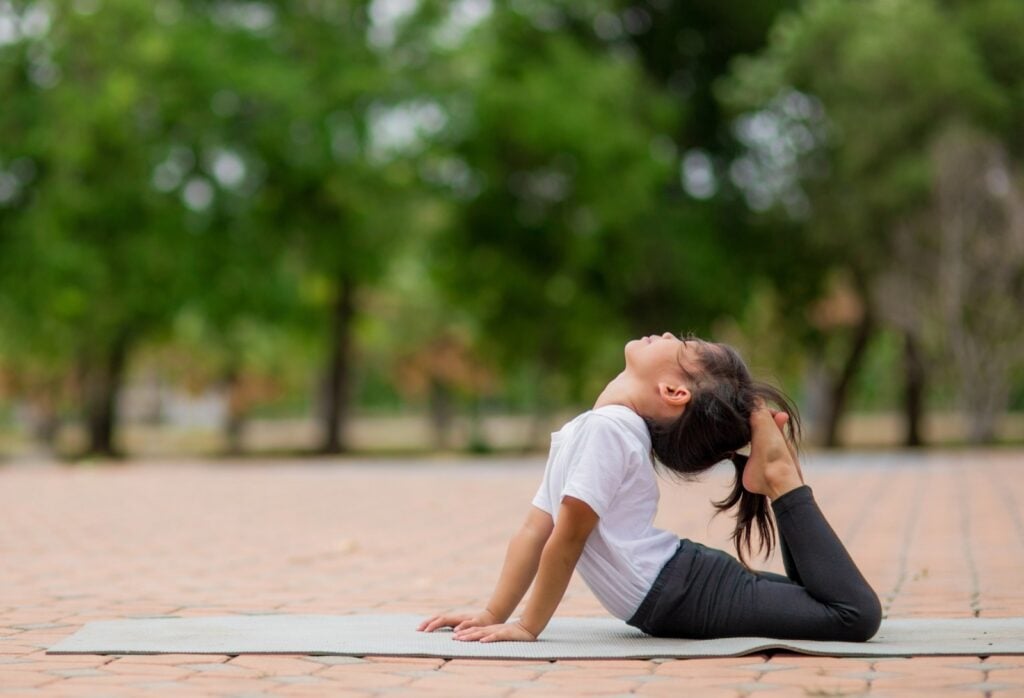The Benefits of Yoga for Kids and Tips for Getting Started
You already know how helpful yoga is for your mind, body, and spirit. The benefits of yoga for kids are just as impactful, and introducing them to yoga may be easier than you think.

Yogis believe a flexible body and an open mind go hand in hand. A natural parenting approach teaches that loving hearts, common sense, and open minds are key to raising compassionate children – an essential step toward creating the peace our planet needs now more than ever.
How Can Yoga Benefit Children?
Yoga combines specific poses, breathing techniques, meditation, and concentration to calm the mind and strengthen the body. Increasingly, parents and educators are turning to yoga as a tool to promote mental health, physical activity, and emotional regulation in children.
As a yoga instructor, I’ve had the joy of teaching kids over the past decade in schools, yoga studios, camps, and even hospitals. Each session has reinforced how yoga benefits children at every stage of their development.
Yoga is inclusive and emphasizes individual abilities rather than competition, making it suitable for all kids — including those with physical challenges or those who are less inclined to participate in traditional sports. It provides a non-threatening way to build strength, flexibility, coordination, and self-awareness, while also offering powerful relaxation techniques that can help children manage their emotions and impulsivity.
By introducing a mindfulness practice like yoga early in life, children establish a foundation of wellness that can carry them through challenges at school, home, and beyond.
The Benefits of Yoga for Kids
Yoga supports children in unique ways as they grow.
- For toddlers, yoga introduces body awareness and builds confidence. Activities like stretching and playing help them recognize how good it feels to move their muscles and connect with their breath.
- For school-age kids, yoga enhances balance, focus, and self-acceptance. It nurtures cooperation and can even include teaching poses to peers, which reinforces the noncompetitive nature of yoga.
- For pre-teens and teens, yoga fosters self-esteem, open-mindedness, and resilience. They often love “challenge poses” like half-moon or handstands and can draw on their practice during stressful times at school, sports, or social situations.
Some of the key benefits of yoga for kids include:
- Enhancing flexibility, strength, and muscle tone
- Calming anxiety and hyperactivity
- Improving focus and behavior, especially for children with ADHD
- Reducing impulsivity, anger, and panic attacks
- Supporting mental health, self-control, and emotional regulation
- Boosting imagination, concentration, and academic performance
- Addressing health concerns like headaches, stomachaches, and constipation
- Helping children with relaxation techniques to reduce stress
Parents of children with attention deficit disorders or other challenges often report that yoga reduces the need for medication and improves overall wellbeing.
How to Practice Yoga With Kids
Whether you bring your child to a yoga class or practice at home, the focus should always be on the joy of movement rather than perfecting poses. Adapting postures and breathing techniques to a child’s developmental needs ensures the experience is positive and engaging.
When teaching yoga to kids, consider these essential elements:
- Environment: Choose a calm, distraction-free space with soft lighting, a yoga mat, and gentle background music.
- Components of the session: Incorporate breathing exercises, age-appropriate yoga poses, games, and relaxation techniques. Many kids enjoy imaginative activities like pretending to be a deflating balloon during breathing exercises.
For example, young children can inhale deeply through their noses and visualize becoming a big, colorful balloon. As they exhale, they “float” around the room, enjoying the playful connection between movement and breath. You can also try a guided deep breathing meditation with them.
A Yoga Practice to Share with Your Child
You can learn much more about yoga for kids and parents here. And here is a simple yoga practice you can enjoy with your child:
- Start seated: Sit comfortably (crisscross applesauce) and take a deep breath in. As you breathe out, chant “Om” to focus your mind and signal the beginning of your practice.
- Cat-Cow Pose: Move onto your hands and knees. Alternate between arching your back into cat pose (exhaling) and dropping your belly into cow pose (inhaling). This flow warms up the spine and engages core muscles.
- Sun Salutations: Stand tall and move through three mini sun salutations, stretching your body and connecting with your breath.
- Butterfly Pose: Sit with the soles of your feet together and your knees out to the sides. Flap your knees like butterfly wings while sitting tall. This pose stretches the inner thighs and encourages healthy joint movement.
Yoga encourages children to embrace change and recognize how their breath can help them manage emotions and navigate life’s challenges with ease.
How Often Should Kids Practice Yoga to See the Benefits?
For the greatest benefit, kids should practice yoga at least once a week. However, practicing four to six times per week helps develop a stronger connection between mind and body while reinforcing self-awareness and relaxation.
Each session should be tailored to the child’s attention span and developmental stage. Even a short practice can help children build confidence, release stress, and strengthen their connection to their own physical and emotional well-being.
If you’ve never tried yoga with your kids, give it a go. Show them your own favorite pose and tell them why it relaxes / stretches / strengthens your body and mind.
They might just surprise you with how flexible their little bodies are… or how quiet and still they can be when you give them the task of focusing on the breath.
More Mindfulness Resources for Kids
Below are some yoga, mindfulness, somatic, and sleep-focused exercises you can try with kids of almost any age.
The Best Yoga Poses for Kids
Somatic Exercises to Release Tension
Benefits of a Calm Down Corner
Sleep-Focused Guided Meditation Scripts for Kids
Mindfulness Toys for Kids
Yoga Gifts for Kids
Outdoor Mindfulness Activities


I teach Kids Yoga twice a week at Yogaworks South Bay in El Segundo, California. Such a joy! Children are the best yogis. No fear, no shame, pure gratitude. Check us out Tuesdays and Thursdays 4:30pm-5:25pm. Open to the public.
Good day! Would you mind if I share your blog with my facebook group?
There’s a lot of people that I think would
really enjoy your content. Please let me know. Thank you